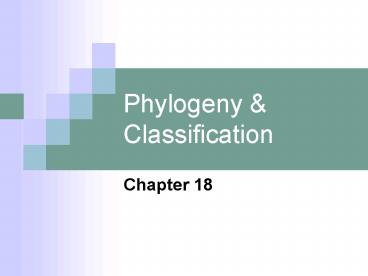Phylogeny - PowerPoint PPT Presentation
Title: Phylogeny
1
Phylogeny Classification
- Chapter 18
2
Kings Play Chess
On Fridays
Generally
Speaking
Linnaean Classification This system was created
long before scientists understood that organisms
evolved. Because the Linnaean system is not based
on evolution, most biologists are switching to a
classification system that reflects the
organisms' evolutionary history.
3
Binomial Nomenclature
- Each species is assigned a two part scientific
name. - Written in italics
- First word is capitalized
- Second word is lowercase
4
Binomial Nomenclature
Homo sapien
Genus
species
human
5
What is a Phylogeny?
- The context of evolutionary biology is phylogeny
- The connections between all groups of organisms
as understood by ancestor/descendant
relationships.
6
Different ways of drawing trees
All of these show the same relationships
7
(No Transcript)
8
Clades
A clade is a grouping that includes a common
ancestor and all the descendents (living and
extinct) of that ancestor. Using a phylogeny, it
is easy to tell if a group of lineages forms a
clade. Imagine clipping a single branch off the
phylogenyall of the organisms on that pruned
branch make up a clade.
9
Identifying Clades
10
Sample Practice Question
- For the tree above, you would need to say
- the frog and salamander are more closely related
to each other than to the lizard, snake, bird,
and mouse - the lizard and snake are more closely related to
each other than to the bird, mouse, frog, or
salamander - the bird is more closely related to the lizard
and the snake than it is to the mouse, frog, or
slamander - the mouse is more closely related to the lizard,
snake, and bird than it is to the frog or
salamander
Information for this practice question comes
from http//www.utm.edu/departments/cens/biology/
rirwin/391/391Phylog.htm
11
Practice Question
Note that the previous example gives four
statements about the relationships one for each
ancestral species on the tree. See if you can
give the same kind of description of
relationships for each of the phylogenies
pictured above.
Information for this practice question comes
from http//www.utm.edu/departments/cens/biology/
rirwin/391/391Phylog.htm
12
Homologies help determine how species are
related.
13
Homology vs. Analogy
- Homologies are similar characteristics shared by
two different organisms because they were
inherited from a common ancestor.
- Analogis are similar characteristics shared by
two different organisms because of convergent
evolution.
14
Molecular Biology is a powerful tool in
classification
- DNA RNA comparisons
- A molecular clock can be calibrated in actual
time. Possible to graph base substitutions
against known evolutionary landmarks.
15
Molecular Clocks
16
Kingdoms Domains
- Linnaeuss two kingdoms, Animalia and Plantae
dont adequately represent the full diversity of
life. - Instead, scientists made five kingdoms
- Monera, Protista, Fungi, Plantae and Animalia
- Then they split Monera into Eubacteria and
Archaebacteria - Leading to the three kingdom system
17
Bacteria Archaea Eukarya Eukarya Eukarya Eukarya
Eubacteria Archaebacteria Protista Fungi Plantae Animalia
Prokaryote Prokaryote Eukaryote Eukaryote Eukaryote Eukaryote
E.coli halophiles Amoeba Mushroom, yeast Moss, ferns, flowering plants Sponges, worms, insects, fishes, mammals































